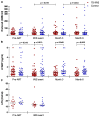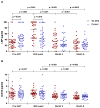LPS-binding protein and IL-6 mark paradoxical tuberculosis immune reconstitution inflammatory syndrome in HIV patients
- PMID: 24312369
- PMCID: PMC3842977
- DOI: 10.1371/journal.pone.0081856
LPS-binding protein and IL-6 mark paradoxical tuberculosis immune reconstitution inflammatory syndrome in HIV patients
Abstract
Background: Tuberculosis-associated immune reconstitution inflammatory syndrome (TB-IRIS) remains a poorly understood complication in HIV-TB co-infected patients initiating antiretroviral therapy (ART). The role of the innate immune system in TB-IRIS is becoming increasingly apparent, however the potential involvement in TB-IRIS of a leaky gut and proteins that interfere with TLR stimulation by binding PAMPs has not been investigated before. Here we aimed to investigate the innate nature of the cytokine response in TB-IRIS and to identify novel potential biomarkers.
Methods: From a large prospective cohort of HIV-TB co-infected patients receiving TB treatment, we compared 40 patients who developed TB-IRIS during the first month of ART with 40 patients matched for age, sex and baseline CD4 count who did not. We analyzed plasma levels of lipopolysaccharide (LPS)-binding protein (LBP), LPS, sCD14, endotoxin-core antibody, intestinal fatty acid-binding protein (I-FABP) and 18 pro-and anti-inflammatory cytokines before and during ART.
Results: We observed lower baseline levels of IL-6 (p = 0.041), GCSF (p = 0.036) and LBP (p = 0.016) in TB-IRIS patients. At IRIS event, we detected higher levels of LBP, IL-1RA, IL-4, IL-6, IL-7, IL-8, G-CSF (p ≤ 0.032) and lower I-FABP levels (p = 0.013) compared to HIV-TB co-infected controls. Only IL-6 showed an independent effect in multivariate models containing significant cytokines from pre-ART (p = 0.039) and during TB-IRIS (p = 0.034).
Conclusion: We report pre-ART IL-6 and LBP levels as well as IL-6, LBP and I-FABP levels during IRIS-event as potential biomarkers in TB-IRIS. Our results show no evidence of the possible contribution of a leaky gut to TB-IRIS and indicate that IL-6 holds a distinct role in the disturbed innate cytokine profile before and during TB-IRIS. Future clinical studies should investigate the importance and clinical relevance of these markers for the diagnosis and treatment of TB-IRIS.
Conflict of interest statement
Figures


References
-
- World Health Organisation (WHO) (2011) TB/HIV FACTS.
-
- Müller M, Wandel S, Colebunders R, Attia S, Furrer H et al. (2010) Immune reconstitution inflammatory syndrome in patients starting antiretroviral therapy for HIV infection: a systematic review and meta-analysis. Lancet Infect Dis 10: 251-261. doi:10.1016/S1473-3099(10)70026-8. PubMed: 20334848. - DOI - PMC - PubMed
Publication types
MeSH terms
Substances
LinkOut - more resources
Full Text Sources
Other Literature Sources
Medical
Research Materials
Miscellaneous

